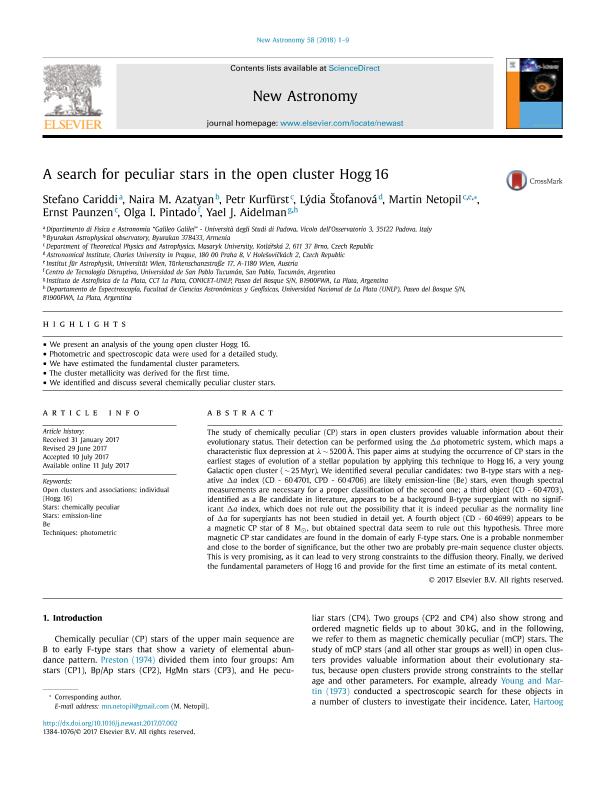Mostrar el registro sencillo del ítem
dc.contributor.author
Cariddi, Stefano
dc.contributor.author
Azatyan, Naira M.
dc.contributor.author
Kurfürst, Petr
dc.contributor.author
Stofanová, Lýdia
dc.contributor.author
Netopil, Martin
dc.contributor.author
Paunzen, Ernst
dc.contributor.author
Pintado, Olga Ines

dc.contributor.author
Aidelman, Yael Judith

dc.date.available
2018-03-26T19:55:50Z
dc.date.issued
2018-01
dc.identifier.citation
Cariddi, Stefano; Azatyan, Naira M.; Kurfürst, Petr; Stofanová, Lýdia; Netopil, Martin; et al.; A search for peculiar stars in the open cluster Hogg 16; Elsevier Science; New Astronomy; 58; 1-2018; 1-9
dc.identifier.issn
1384-1076
dc.identifier.uri
http://hdl.handle.net/11336/40000
dc.description.abstract
The study of chemically peculiar (CP) stars in open clusters provides valuable information about their evolutionary status. Their detection can be performed using the Δa photometric system, which maps a characteristic flux depression at λ ∼ 5200 Å. This paper aims at studying the occurrence of CP stars in the earliest stages of evolution of a stellar population by applying this technique to Hogg 16, a very young Galactic open cluster (∼ 25 Myr). We identified several peculiar candidates: two B-type stars with a negative Δa index (CD - 60 4701, CPD - 60 4706) are likely emission-line (Be) stars, even though spectral measurements are necessary for a proper classification of the second one; a third object (CD - 60 4703), identified as a Be candidate in literature, appears to be a background B-type supergiant with no significant Δa index, which does not rule out the possibility that it is indeed peculiar as the normality line of Δa for supergiants has not been studied in detail yet. A fourth object (CD - 60 4699) appears to be a magnetic CP star of 8 M⊙, but obtained spectral data seem to rule out this hypothesis. Three more magnetic CP star candidates are found in the domain of early F-type stars. One is a probable nonmember and close to the border of significance, but the other two are probably pre-main sequence cluster objects. This is very promising, as it can lead to very strong constraints to the diffusion theory. Finally, we derived the fundamental parameters of Hogg 16 and provide for the first time an estimate of its metal content.
dc.format
application/pdf
dc.language.iso
eng
dc.publisher
Elsevier Science

dc.rights
info:eu-repo/semantics/openAccess
dc.rights.uri
https://creativecommons.org/licenses/by-nc-sa/2.5/ar/
dc.subject
Be
dc.subject
Open Clusters And Associations: Individual (Hogg 16)
dc.subject
Stars: Chemically Peculiar
dc.subject
Stars: Emission-Line
dc.subject
Techniques: Photometric
dc.subject.classification
Astronomía

dc.subject.classification
Ciencias Físicas

dc.subject.classification
CIENCIAS NATURALES Y EXACTAS

dc.title
A search for peculiar stars in the open cluster Hogg 16
dc.type
info:eu-repo/semantics/article
dc.type
info:ar-repo/semantics/artículo
dc.type
info:eu-repo/semantics/publishedVersion
dc.date.updated
2018-03-26T14:39:14Z
dc.journal.volume
58
dc.journal.pagination
1-9
dc.journal.pais
Países Bajos

dc.journal.ciudad
Amsterdam
dc.description.fil
Fil: Cariddi, Stefano. Università di Padova; Italia
dc.description.fil
Fil: Azatyan, Naira M.. Byurakan Astrophysical Observatory; Armenia
dc.description.fil
Fil: Kurfürst, Petr. Masaryk University; República Checa
dc.description.fil
Fil: Stofanová, Lýdia. Charles University in Prague; República Checa
dc.description.fil
Fil: Netopil, Martin. Masaryk University; República Checa. Technische Universitat Wien; Austria
dc.description.fil
Fil: Paunzen, Ernst. Masaryk University; República Checa
dc.description.fil
Fil: Pintado, Olga Ines. Universidad de San Pablo. Centro de Tecnología Disruptiva; Argentina
dc.description.fil
Fil: Aidelman, Yael Judith. Consejo Nacional de Investigaciones Científicas y Técnicas. Centro Científico Tecnológico Conicet - La Plata. Instituto de Astrofísica La Plata. Universidad Nacional de La Plata. Facultad de Ciencias Astronómicas y Geofísicas. Instituto de Astrofísica La Plata; Argentina. Universidad Nacional de La Plata. Facultad de Ciencias Astronómicas y Geofísicas; Argentina
dc.journal.title
New Astronomy

dc.relation.alternativeid
info:eu-repo/semantics/altIdentifier/doi/http://dx.doi.org/10.1016/j.newast.2017.07.002
dc.relation.alternativeid
info:eu-repo/semantics/altIdentifier/url/https://www.sciencedirect.com/science/article/pii/S1384107617300404
Archivos asociados
